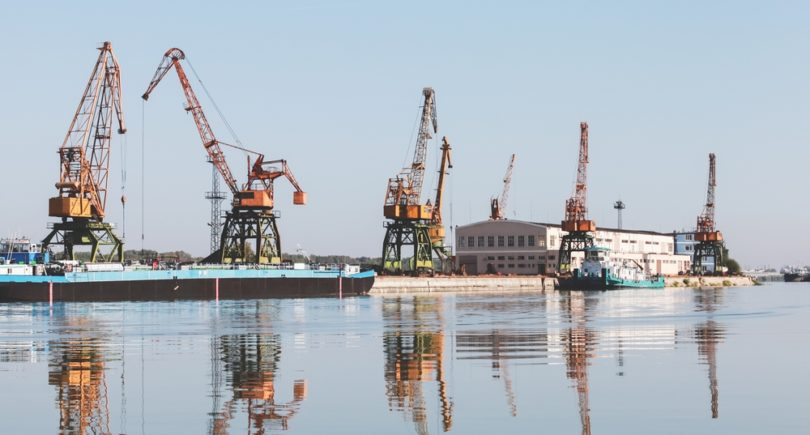
Posts Infrastructure railway tariffs 145 19 May 2025
Another increase in freight tariffs could be a disaster for the state, business and Ukrainian Railways itself
The second half of last year was a challenging time for business not only because of the war but also because of drastic changes in the tariff policy of state monopolies. Energy and gas state-owned companies, as well as Ukrainian Railways, saw financial gaps in their balance sheets and decided to fill them at the expense of industrial consumers.
At the same time, the monopolists try not to mention improving the efficiency of their own operations and optimizing costs, as raising tariffs for consumers is a simpler and easier way. However, no one calculates the negative impact of such decisions on the Ukrainian economy, and the consequences can be catastrophic.
Tariff history
Since 2021, there has been a significant increase in tariffs for the transportation of goods by rail. Ukrainian Railways can raise tariffs in different ways: a direct increase, indexation, or convergence of tariff classes. The last increase took place at the end of June 2022. At that time, tariffs for the transportation of coal, ore and limestone increased by 140%, grain by 96%, and metal by 70%.
In August-September last year, Ukrainian Railways attempted to increase tariffs by unifying tariff classes, which meant a 52% increase in the cost of transportation of building materials, a 7% increase in the cost of ore and coal, and a 67% increase in the return of empty cars. But then Ukrainian business united against this idea, and it was not implemented. However, Ukrainian Railways will still try to return to the idea of unification.
Now Ukrainian Railways is trying to raise tariffs by indexing them by 37%. As in previous cases, this is motivated by the need to ensure profitable operations and a sharp increase in costs.
While in 2022, the business treated the tariff increase with a certain understanding of the situation, as after the outbreak of war, UZ had a sharp decline in freight traffic and performed crucial social and defense functions, now the business categorically rejects any attempts to “impose” an additional financial burden on itself.
“Given the 70% increase in tariffs in the summer of 2022, no inflation indices or economic indicators during the war can justify a tariff increase in 2025,” Ukrcement Association said in a comment to GMK Center.
The indexation would have brought Ukrainian Railways 17.5 billion by the end of the year if the decision had come into effect on May 1. According to UZ estimates, the logistics component of the cost of cargo will increase by about 2.7% for iron ore and up to 1% for coal and ferrous metals. At the same time, shippers expect a much more significant absolute effect.
Implications for business
The negative attitude of business to the indexation of Ukrainian Railways’ freight tariffs is due to the difficult situation in most sectors of the Ukrainian economy, which are barely surviving the war and receive no help from the state, or at least no obstacles to their business activities, but rather the transfer of the problems of one single state-owned enterprise to the entire economy.
The expected negative impact of the indexation of Ukrainian Railways’ freight tariffs on the largest sectors of the Ukrainian economy includes the following:
- Increase in overall logistics costs. According to the European Business Association, as a result of Russian military aggression, logistics costs have increased significantly, in some industries – up to 40% of the cost of production, and current tariffs already exceed the capacity of market participants. At the same time, a 37% indexation will lead to a disproportionate increase in logistics costs for most sectors of the economy. According to Ksenia Orynchak, Executive Director of the National Association of Extractive Industries of Ukraine (NAEIU), the total increase in transportation costs for the extractive industry alone could exceed UAH 10 billion per year if this decision is approved.
- Increased production costs and loss of competitiveness. The increase in transportation costs is automatically included in the cost of production, which may lead to a deterioration in the competitiveness of Ukrainian producers both on the foreign and domestic markets. According to NAEIU calculations, the indexation of UZ tariffs could increase the cost of a ton of ore by at least $2-3, and a ton of coal by $5-7, depending on the distance of transportation.
- Reduced production and exports. The logical response of businesses to the increase in transportation costs and reduced competitiveness may be to reduce production volumes and, in some cases, even to stop operations. Earlier, ArcelorMittal Kryvyi Rih announced a decline in production due to rising electricity prices and unfavorable market conditions. Now, an increase in rail freight tariffs may be added to the negative factors.
- Shift to motorized transportation and accelerated road deterioration. Due to rising tariffs, freight owners will switch to road transport, which will increase the load on roads and accelerate their destruction, which will be especially noticeable in the context of limited funding for road infrastructure during the war.
- Rising inflation. Any increase in UZ tariffs will lead to a chain of price increases by cargo owners. Thus, the actions of Ukrainian Railways make a significant contribution to the increase in industrial inflation.
- Accumulation of industrial losses. Many Ukrainian companies are already making losses or are operating on the edge of profitability. In particular, Metinvest Group suffered losses of $1.15 billion in 2024, and ArcelorMittal Kryvyi Rih’s operations are actually supported by its parent company, which has provided financial assistance worth $1+ billion since the beginning of the war.
- Multiplier effect on related industries. Problems in a particular sector of the economy will inevitably have a negative impact on other sectors, even if they are doing better. For example, problems in metallurgy or mining will have a domino effect on logistics, energy, engineering, etc.
“The mere increase in tariffs without compensatory measures may have a negative effect. The likely increase in tariffs will have a different effect on different sectors of the economy, but the construction industry will be the most negatively affected. Not only is the economic justification for the changes important, but also the adaptation of freight transportation standards to international requirements in connection with European integration processes. It is worth noting that UZ has proposed compensation mechanisms for various industries, such as long-term contracts at fixed rates, etc.,” Anatoliy Kinakh, President of the Ukrainian League of Industrialists and Entrepreneurs, commented to GMK Center.
In addition, the indexation of tariffs will lead to significant negative consequences not only for large industrial enterprises but also for small companies.
“The increase in tariffs for freight transportation by Ukrainian Railways may have a significant negative impact on the agricultural sector of Ukraine, especially on small and medium-sized farms. This could lead to lower yields, reduced production and exports, and a general deterioration of the economic situation in communities. In this regard, farmers are calling for a review of the tariff policy and the introduction of a transparent tariff setting mechanism that would take into account the interests of all market participants,” the Ukrainian Agrarian Council told GMK Center.
An important problem is that the increase in railroad tariffs is not accompanied by real changes and improvements in the quality of cargo transportation. During the previous increases in the cost of freight transportation, the set goals were not achieved, in particular, an increase in the volume of capital investments, and according to shippers, the level of service of UZ is quite low.
“During the recent periods of rail tariff increases, Ukrainian Railways has not renewed the rolling stock of cement cars. We have repeatedly offered to replace cement hoppers with higher carrying capacity or technical modernization,” Ukrcement Association emphasizes.
On May 16, intermodal market operators appealed to Oleksiy Kuleba, Deputy Prime Minister for Reconstruction and Minister of Community and Territorial Development, to prevent Ukrzaliznytsia from raising the price of container transportation.
Consequences for the state and the economy
It is difficult to estimate the losses for the state and the entire Ukrainian economy in terms of GDP decline, reduced foreign exchange earnings and taxes, but they will be in the tens of billions of hryvnias. Thousands of jobs will be at risk if the plant is shut down or completely ceases production. Increased production costs and loss of competitiveness.
“If we use medical terminology, the 37% indexation of tariffs is a blood clot. If it breaks, it will be almost impossible to pump out the patient (the Ukrainian economy). Personally, I believe that such intentions of Ukrainian Railways are a deliberate diversion, a chaotic attempt to find additional funds somewhere without any other changes, such as developing additional services, running an efficient state-owned enterprise, etc.”, said Konstantin Saliy, President of the All-Ukrainian Union of Building Materials Manufacturers, in a commentary to GMK Center.
The negative consequences will also affect Ukrainian Railways directly, as cargo owners will be forced to switch to alternative modes of transportation, which will cause the state carrier to lose its cargo base, which will negatively affect Ukrainian Railways’ revenues and significantly worsen its current financial position.
“The decline in industrial production will also have a negative impact on Ukrainian Railways itself, as the only source of its income is shippers, who will be forced to reduce transportation volumes due to excessive tariff burden,” the American Chamber of Commerce in Ukraine (ACC) explains.
In fact, Ukrainian Railways started losing it last year. In the second half of 2024, compared to the first half, the total volume of UZ freight traffic decreased by 6.2% or 5.6 million tons, while export traffic decreased by 10.8% or 4.9 million tons.
“As a result of the indexation of Ukrainian Railways tariffs, transportation of certain types of products will be at risk – they will either lose their competitive position or switch to road transport. For example, this applies to the transportation of liquefied gas, which used to be carried out by rail, but is now largely carried out by road. A similar trend applies to the transportation of light oil products. There are also more sensitive categories, such as the transportation of timber in the frontline regions for the construction of fortifications,” said Serhiy Vovk, Director of the Center for Transportation Strategies, in a commentary to GMK Center.
Most importantly, the tariff increase does not solve the systemic problems of Ukrainian Railways that have been accumulating over the years: inflated prices during procurement, inefficient infrastructure that generates only losses and cross-subsidization of unprofitable passenger transportation.
“Instead of raising tariffs, which will increase financial pressure on businesses and lead to a reduction in transportation volumes, it is important to focus on supporting exports. Preventing the growth of logistics costs will help keep cargo on the railroad, preserve foreign exchange earnings to the budget and contribute to economic stability,” the European Business Association believes.
What to do?
First of all, tariffs for freight transportation should be economically justified. This approach is the only acceptable one in the current situation, especially in the context of the country’s post-war recovery and the arrival of foreign investors interested in developing Ukraine’s raw materials and production base.
“The only right way out is not to increase tariffs, but to recalculate them by type of cargo and level of infrastructure utilization, for which a new fair tariff book should be approved.” It is also necessary to make a decision on restructuring UZ’s assets, spinning off certain companies, etc. All of this will take a lot of time, but we need to start today,” said Olexander Kalenkov, President of Ukrmetprom, in a commentary to GMK Center.
Increasing tariffs will increase the financial burden on businesses, which, given the current conditions in which the Ukrainian economy is operating, looks ill-advised and will have extremely negative consequences. According to Serhiy Vovk, it is necessary to look for other options to improve the financial condition of Ukrainian Railways: to reduce losses and look for budgetary compensators for passenger transportation, to work on optimizing, in particular, inactive infrastructure, because the current cross-subsidization model has exhausted itself and requires fundamental reform.
The reserve for increasing efficiency lies in optimizing costs and covering losses. Ukrainian Railways’ annual uncovered losses from passenger transportation amount to UAH 20+ billion, and the cost of maintaining inactive infrastructure is approximately UAH 16 billion per year.
It is important to note that on the way to EU membership, Ukraine will have to adopt the European model in the field of transportation. According to Directive 2014/34/EU, losses from passenger transportation cannot be covered by revenues from freight transportation. This means that the state will have to look for some sources to cover losses from passenger transportation, and Ukrainian Railways will probably not have to significantly increase freight tariffs every year.
However, all these are post-war prospects, and the key task of the state now is to maintain the military and economic front, without which there will be no prospects.
“Ukrainian shippers have the right to expect a civilized attitude. I believe that during the war, Ukrainian Railways cannot focus solely on profit, as the main goal now is to keep the economy from collapsing,” summarizes Konstantin Saliy.





